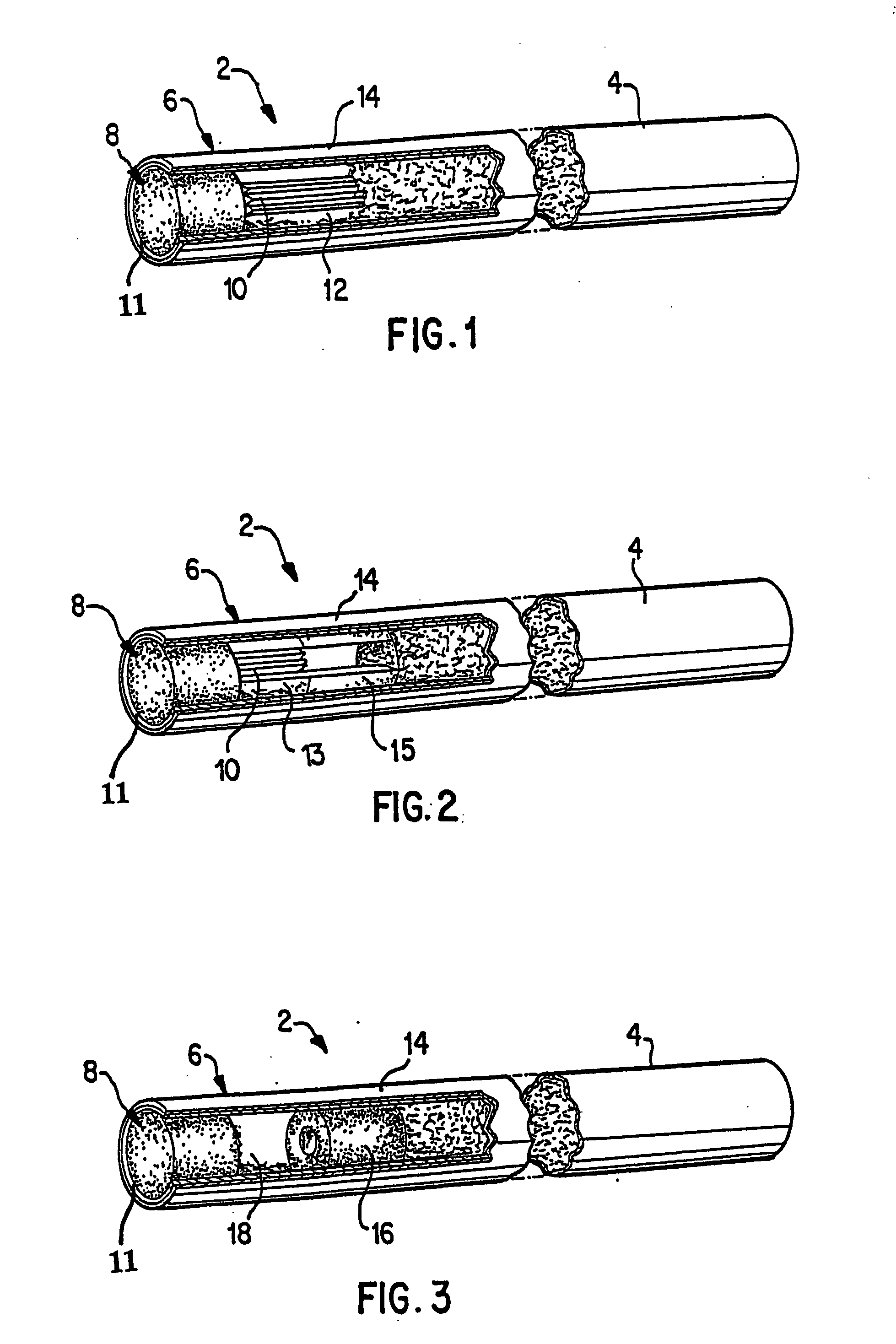Smoking articles and filters with carbon-coated molecular sieve sorbent
a technology of molecular sieve and carbon coating, which is applied in the field of carbon coating molecular sieve sorbent for smoking articles and filters, can solve the problems of not being optimal for the removal of gaseous components of tobacco smok
- Summary
- Abstract
- Description
- Claims
- Application Information
AI Technical Summary
Benefits of technology
Problems solved by technology
Method used
Image
Examples
example 1
[0062] Sucrose is used as a carbon source and loaded into a mesoporous SBA-15 molecular sieve silicate substrate via incipient-wetness impregnation in water. One gram of mesoporous SBA-15 molecular sieve silicate, with a uniform pore size of about 67 Å (FIG. 9), is added to 10 milliliters of an aqueous solution containing 1.25 grams of sucrose, and 0.14 grams of concentrated sulfuric acid (used as a catalyst for carbonization). The mixture is slurried and dried at 100° C. for about 12 hours, then heated at 160° C. for about 12 hours yielding a yellowish composite material. The composite material is carbonized at 843° C. under a 0.5 liter / minute flow of nitrogen for about 1 hour, followed by activation at 950° C. under a 0.5 liter / minute flow of carbon dioxide for about 0.5 hours, yielding a carbon-coated mesoporous SBA-15 molecular sieve silicate (Sample 1).
[0063] The carbon loading is controlled by the concentration of sucrose used in the aqueous solution for impregnation. Pore st...
example 2
[0065] Phenolic resin is used as a carbon source and loaded into a mesoporous SBA-15 molecular sieve silicate substrate via incipient-wetness impregnation in ethanol. To 1 gram of the mesoporous SBA-15 molecular sieve silicate are added 10 milliliters of an ethanolic solution containing 2 grams of a phenolic resin (average molecular weight 900), and 0.04 grams of concentrated phosphoric acid (used as a catalyst for carbonization). The mixture is slurried and dried at 100° C. for about 12 hours, then heated at 160° C. for about 12 hours yielding a dark composite material. The composite material is carbonized at 843° C. under a 0.5 liter / minute flow of nitrogen for about 1 hour, followed by activation at 950° C. under a 0.5 liter / minute flow of carbon dioxide for about 0.5 hours, yielding a carbon-coated mesoporous SBA-15 molecular sieve silicate (Sample 2).
[0066] In this preparation, the desired carbon loading is controlled by the concentration of the phenolic resin used in the etha...
example 3
[0067] Resorcinol and formaldehyde are used as the carbon source and loaded into a mesoporous SBA-15 molecular sieve silicate substrate via incipient-wetness impregnation in water. To 1 gram of the mesoporous SBA-15 molecular sieve silicate are added 10 milliliters of an aqueous solution containing 2.2 grams of resorcinol, 1.2 grams of formaldehyde, and 0.03 grams of sodium carbonate (used as a catalyst for carbonization). The mixture is slurried and dried at 100° C. for about 12 hours, then heated at 160° C. for about 12 hours yielding a reddish composite material. The composite material is carbonized at 843° C. under a 0.5 liter / minute flow of nitrogen for about 1 hour, followed by activation at 950° C. under a 0.5 liter / minute flow of carbon dioxide for about 0.5 hours, yielding a carbon coated mesoporous SBA-15 molecular sieve silicate (Sample 3).
[0068] In this preparation, the carbon loading is controlled by the concentration of resorcinol and formaldehyde used in the aqueous ...
PUM
 Login to View More
Login to View More Abstract
Description
Claims
Application Information
 Login to View More
Login to View More - R&D
- Intellectual Property
- Life Sciences
- Materials
- Tech Scout
- Unparalleled Data Quality
- Higher Quality Content
- 60% Fewer Hallucinations
Browse by: Latest US Patents, China's latest patents, Technical Efficacy Thesaurus, Application Domain, Technology Topic, Popular Technical Reports.
© 2025 PatSnap. All rights reserved.Legal|Privacy policy|Modern Slavery Act Transparency Statement|Sitemap|About US| Contact US: help@patsnap.com



